In molecular biology, biosynthesis is a multi-step, enzyme-catalyzed process where substrates are converted into more complex products in living organisms. In biosynthesis, simple compounds are modified, converted into other compounds, or joined to form macromolecules. This process often consists of metabolic pathways. Some of these biosynthetic pathways are located within a single cellular organelle, while others involve enzymes that are located within multiple cellular organelles. Examples of these biosynthetic pathways include the production of lipid membrane components and nucleotides. Biosynthesis is usually synonymous with anabolism.
In enzymology, a diaminopimelate dehydrogenase (EC 1.4.1.16) is an enzyme that catalyzes the chemical reaction
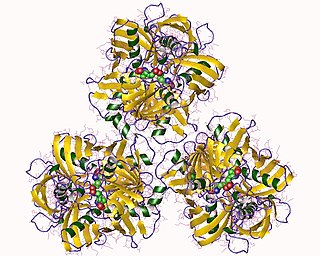
In enzymology, a diaminopimelate epimerase is an enzyme that catalyzes the chemical reaction

The enzyme diaminopimelate decarboxylase (EC 4.1.1.20) catalyzes the cleavage of carbon-carbon bonds in meso 2,6 diaminoheptanedioate to produce CO2 and L-lysine, the essential amino acid. It employs the cofactor pyridoxal phosphate, also known as PLP, which participates in numerous enzymatic transamination, decarboxylation and deamination reactions.
In enzymology, an aerobactin synthase (EC 6.3.2.39) is an enzyme that catalyzes the chemical reaction
The enzyme ectoine synthase (EC ) catalyzes the chemical reaction
In enzymology, a 4-acetamidobutyrate deacetylase (EC 3.5.1.63) is an enzyme that catalyzes the chemical reaction
In enzymology, an acyl-lysine deacylase (EC 3.5.1.17) is an enzyme that catalyzes the chemical reaction
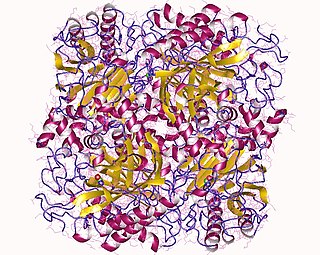
In enzymology, a formamidase (EC 3.5.1.49) is an enzyme that catalyzes the chemical reaction

In enzymology, N-acetylglucosamine-6-phosphate deacetylase (EC 3.5.1.25), also known as GlcNAc-6-phosphate deacetylase or NagA, is an enzyme that catalyzes the deacetylation of N-acetylglucosamine-6-phosphate (GlcNAc-6-P) to glucosamine-6-phosphate (GlcN-6-P):
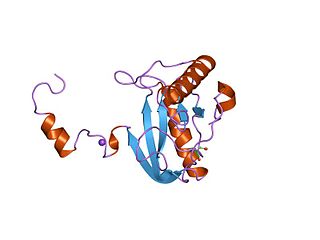
In enzymology, a N-acetylmuramoyl-L-alanine amidase is an enzyme that catalyzes a chemical reaction that cleaves the link between N-acetylmuramoyl residues and L-amino acid residues in certain cell-wall glycopeptides.
In enzymology, a pentanamidase (EC 3.5.1.50) is an enzyme that catalyzes the chemical reaction
In enzymology, a (S)-N-acetyl-1-phenylethylamine hydrolase (EC 3.5.1.85) is an enzyme that catalyzes the chemical reaction
In enzymology, a succinyl-diaminopimelate desuccinylase (EC 3.5.1.18) is an enzyme that catalyzes the chemical reaction
In enzymology, a diaminobutyrate acetyltransferase (EC 2.3.1.178) is an enzyme that catalyzes the chemical reaction
In enzymology, a tetrahydrodipicolinate N-acetyltransferase (EC 2.3.1.89) is an enzyme that catalyzes the chemical reaction
In enzymology, a L,L-diaminopimelate aminotransferase (EC 2.6.1.83) is an enzyme that catalyzes the chemical reaction
In enzymology, a succinyldiaminopimelate transaminase is an enzyme that catalyzes the chemical reaction
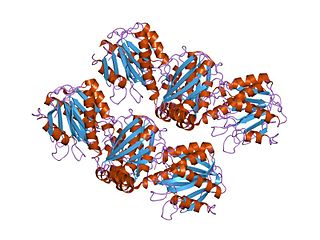
In molecular biology, members of the ArgJ protein family are bifunctional protein that catalyses the first and fifth steps in arginine biosynthesis. The structure has been determined for glutamate N-acetyltransferase 2, an ArgJ-like protein from Streptomyces clavuligerus.
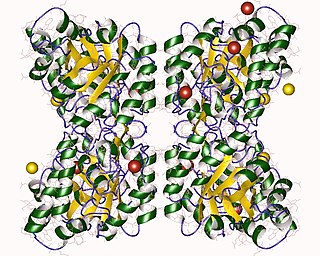
4-Hydroxy-tetrahydrodipicolinate synthase (EC 4.3.3.7, dihydrodipicolinate synthase, dihydropicolinate synthetase, dihydrodipicolinic acid synthase, L-aspartate-4-semialdehyde hydro-lyase (adding pyruvate and cyclizing), dapA (gene)) is an enzyme with the systematic name L-aspartate-4-semialdehyde hydro-lyase (adding pyruvate and cyclizing; (4S)-4-hydroxy-2,3,4,5-tetrahydro-(2S)-dipicolinate-forming). This enzyme catalyses the following chemical reaction







